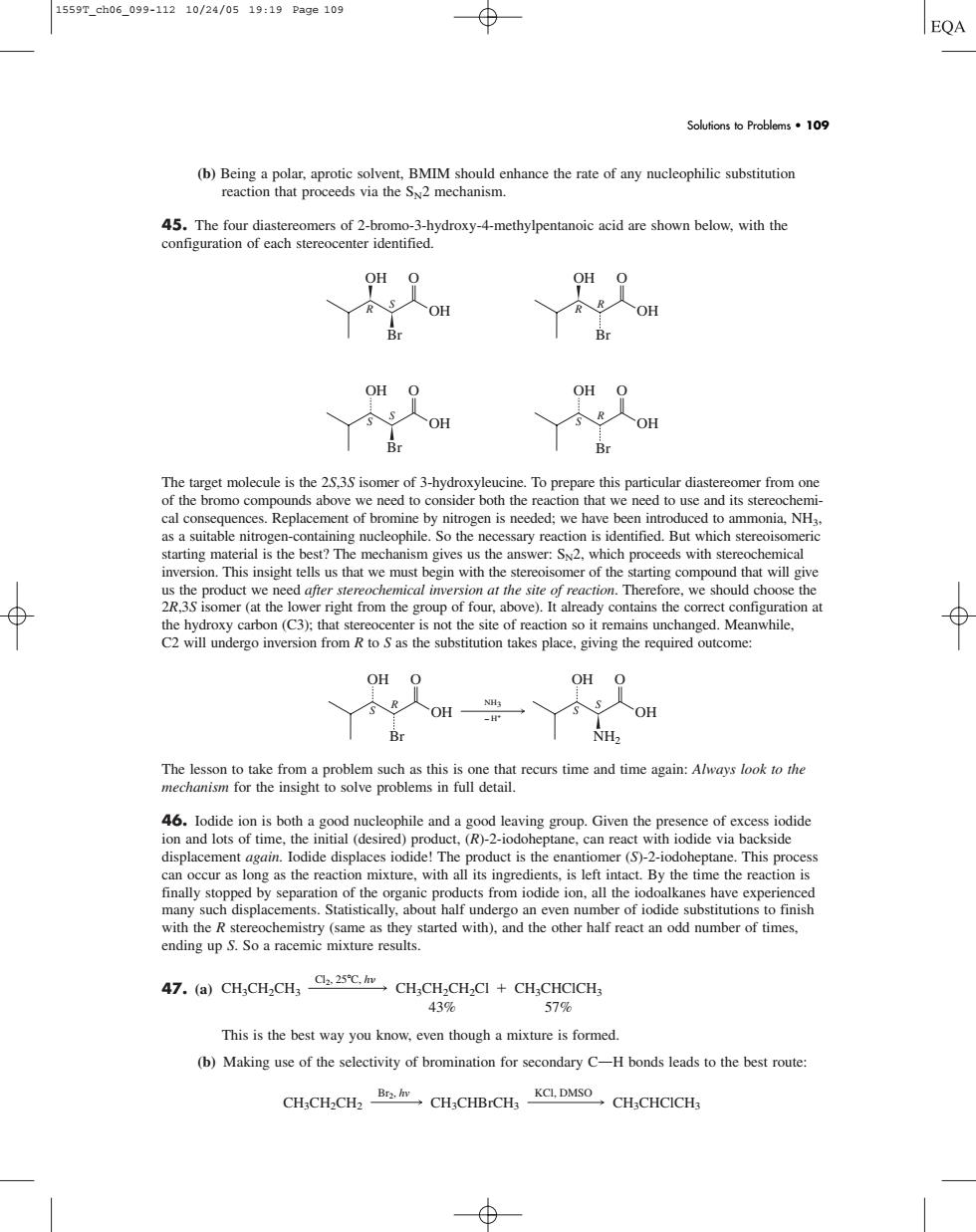正在加载图片...

1559T_ch06_099-11210/24/0519:19Pa9e109 ⊕ EQA Solutions to Problems.109 45.The four diaster mo-3-hydroxy-4-methylpentanoic acid are shown below.with the Br The target molecule is the isomer of 3-hydroxyleucine.To prepare this particular diastereomer from one the bromo der both the reaction that we need to use and its stere as a suitable nitroge containing nucleophile.So the necessary reaction is identified.But which stereoisomeric nroduct we need after s R.3S isomer (at the lo ght from the group of four.above).It aready o that in OH O OH O 人oH"一 OH 46.Iodide ion is both e of on and lots of time,the ne.This proces finally stopped by separation of the organic products from iodide ion.a the iodoalkancs have with), ending up S.So a racemie mixture results. 47.CH,CH.CH,CH,CH.CHCI+CH.CHCICH 439% 57% This is the best way you know.even though a mixture is formed. (b)Making use of the selectivity of bromination for secondary C-H bonds leads to the best route CH;CH-CH CHsCHBrCH KC.DMSO CH:CHCICH (b) Being a polar, aprotic solvent, BMIM should enhance the rate of any nucleophilic substitution reaction that proceeds via the SN2 mechanism. 45. The four diastereomers of 2-bromo-3-hydroxy-4-methylpentanoic acid are shown below, with the configuration of each stereocenter identified. The target molecule is the 2S,3S isomer of 3-hydroxyleucine. To prepare this particular diastereomer from one of the bromo compounds above we need to consider both the reaction that we need to use and its stereochemical consequences. Replacement of bromine by nitrogen is needed; we have been introduced to ammonia, NH3, as a suitable nitrogen-containing nucleophile. So the necessary reaction is identified. But which stereoisomeric starting material is the best? The mechanism gives us the answer: SN2, which proceeds with stereochemical inversion. This insight tells us that we must begin with the stereoisomer of the starting compound that will give us the product we need after stereochemical inversion at the site of reaction. Therefore, we should choose the 2R,3S isomer (at the lower right from the group of four, above). It already contains the correct configuration at the hydroxy carbon (C3); that stereocenter is not the site of reaction so it remains unchanged. Meanwhile, C2 will undergo inversion from R to S as the substitution takes place, giving the required outcome: The lesson to take from a problem such as this is one that recurs time and time again: Always look to the mechanism for the insight to solve problems in full detail. 46. Iodide ion is both a good nucleophile and a good leaving group. Given the presence of excess iodide ion and lots of time, the initial (desired) product, (R)-2-iodoheptane, can react with iodide via backside displacement again. Iodide displaces iodide! The product is the enantiomer (S)-2-iodoheptane. This process can occur as long as the reaction mixture, with all its ingredients, is left intact. By the time the reaction is finally stopped by separation of the organic products from iodide ion, all the iodoalkanes have experienced many such displacements. Statistically, about half undergo an even number of iodide substitutions to finish with the R stereochemistry (same as they started with), and the other half react an odd number of times, ending up S. So a racemic mixture results. 47. (a) This is the best way you know, even though a mixture is formed. (b) Making use of the selectivity of bromination for secondary COH bonds leads to the best route: CH3CH2CH2 CH3CHBrCH3 CH3CHClCH3 Br2, hv KCl, DMSO CH3CH2CH3 CH3CH2CH2Cl CH 3CHClCH3 Cl2, 25C, h 43% 57% OH S S R S NH2 OH Br NH3 OH – H+ O OH O OH Br OH OH S S S R R S R R Br OH O Br OH O OH O OH O Br OH Solutions to Problems • 109 1559T_ch06_099-112 10/24/05 19:19 Page 109��